
Continued from part five. Having wisely decided to move to a more secure location, the question now was where? The trail to town was submerged, and the security of the town itself was an open question. So south wasn’t looking good. North looked a lot more promising. The Chase trail is on the west ( downstream) side of the tracks/dam and was still dry north of the bridge. We decided to move just the short distance to the west side of the rail grade and make camp there. If things worsened, we would be in a good position to retreat north, even literally head for the hills if need be. Just a short move, but if we stayed at the cabin and the water got significantly higher, we would be cut off from the only good escape route.
So how hard can it be to move seven sled dogs a few hundred yards? For those of you who don’t know sled dogs, I will tell you – pretty hard. These guys are very very good at the things they do, like pulling sleds – and getting themselves into trouble. ?And they are very very bad at the things they don’t normally do, like swimming, coming when called, or behaving remotely like domesticated animals. And they were all of course very worked up – another one of their major skills. It took about an hour. Or was it two hours? Think rodeo. African wildlife documentary, stampeding wildebeasts. Mud wrestling. Rugby. My one lasting image is of Ajax, standing chin-deep in water in his wet black tuxedo, 10 feet from the correct shore, deciding he couldn’t do it, and heading back the 90 feet he had already come – while over his head sails “free willie” Ivory, on his sixth crossing as a dolphin-gazelle, screaming dog yahoos at the top of his considerable lungs.
We reached our destination, all hands accounted for and no blood.
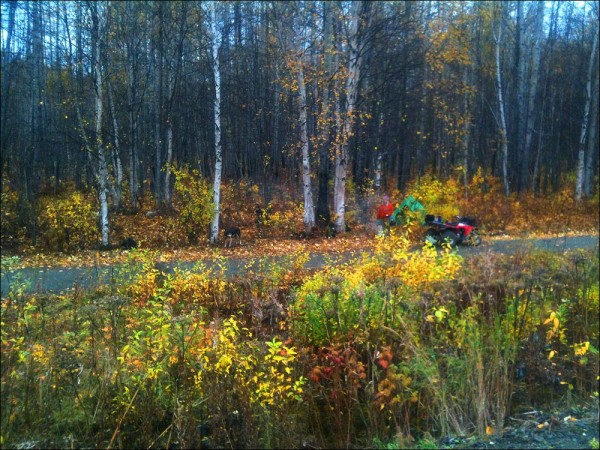
Six of the seven dogs can be seen in this photo of the west-side camp, if you look carefully. Click to enlarge.
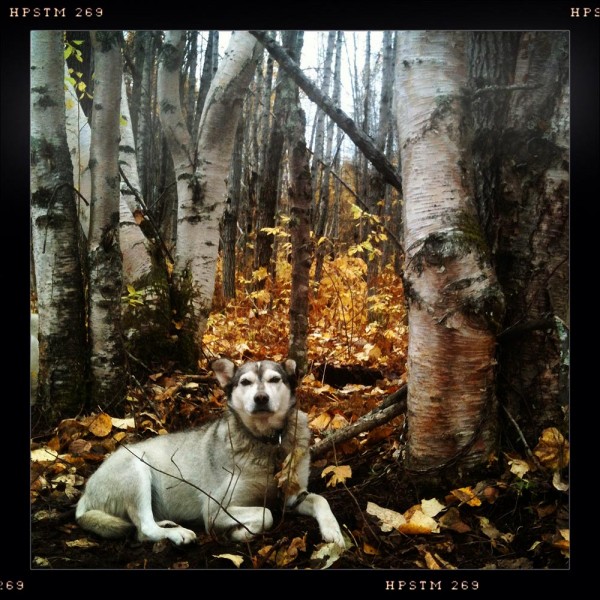
Jenny, calmly posing for Dog Beauty Magazine and enjoying all the great new smells. Hipstamatic Photo by Elf.
With the dogs all curled up in the woods, on nice fresh leaves actually better than their dogyards, a fire going, and darkness closing in, we settled down for the night. It was actually very nice. And if we had to, we could have been on the move in about ten minutes. The wheeler was parked facing north, gangline hooked to the front end , and harnesses already attached. It didn’t come to that, but we were ready.
Night passed with gentle rain, the roaring of the river in the darkness, and the odd absence of trains – the track had washed out at Gold Creek north of us. A fiery dawn revealed the river down just a bit, and hope that the crisis had peaked.
In our flight from the cabin, Annie had managed to pack exactly what we would need to spend a comfortable night and have some food, -and the all important coffee- in the morning.
Over breakfast, I talked to family and friends on “the outside”, and reassured those who had last seen Annie headed INTO the flood that she was fine and taking pictures.
That turned out to indeed be the peak of the flood. For days the river remained at levels that would previously have seemed ominous and now felt strangely reassuring. And it slowly, slowly, went down, revealing a devastated and much-changed landscape. I will post some more pictures of that soon.
We went back to the cabin that day, all was well, and the dogs enjoyed their outing very much. In another day the Chase trail was navigable by wheeler, although I did pass a salmon swimming by me in the other lane on my way in to town.
…Continued from part four.With the Honda humming along, I now had phone and internet once again. I called Steve and found out the wall of water had actually been predicted for the Susitna River, not the Talkeetna. However, this close to the confluence, it could still raise my level if the Susitna backed up the slough. Wait and watch, I guess.
Now it was time to walk towards town to meet Annie. I canoed to the tracks again, and started walking south. By now the river was significantly higher than just a few hours ago. On my left the flooded woods was within three or four vertical feet of coming over the tracks. While on my right I was looking down at the flooded Chase trail, at least ten feet lower. Clearly the railroad embankment was acting as a dam. I later learned that it had the same effect in town, flooding the east side of town, while sparing houses on the west side, including downtown. Again, I? noticed what a gorgeous day it was, sunshine and blue sky la-dee-dah. Made everything seem even weirder.
Before long I was very happy to see Annie appear from around the bend, a brightly colored speck walking north. She said she had to talk her way past 3 roadblocks, and felt like the only rat climbing UP the ropes to the ship. Her trip across the catwalk had been very scary, the bridge just humming with the raw power of the water blasting underneath, trees smashing into the abutments, while a helicopter followed her overhead. Yes, they were in fact evacuating Talkeetna, and the road was blocked at the top of the hill on the way into town. As we walked north, I looked around through her eyes, as mine had at least a couple days to get used to the situation. The railroad embankment we walked on was the only land in sight in any direction. Everything else was a loud chaos of fast moving, ice cold brown water. Not for the first time I thought – she’s a brave woman.
Back to the cabin we went, via Canoes Two and One. I moved some things up into the cabin, tied things to trees, etc. But mostly we just watched the river rising…and rising…..and rising…
It was now over the upper bank and into the front yard. The dog yard was underwater.
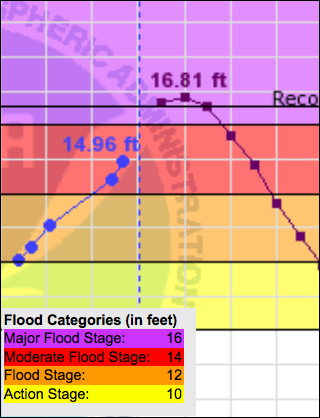
When I saw this, I knew it was time.
Around four o’clock Annie said she thought we should move the dogs and ourselves to a more strategic location. I was hesitant, not wanting to leave the cabin, and not wanting to do all the work involved in relocating – I had already had a long night and day. Well, she said, we can do it now, with the sun shining, or we can do it at 3 A.M. in the dark with the rain blowing sideways. She had a point. I pulled up the river forecast on the web. The dotted vertical line represents the current point in time. We were at 15 feet and predicted to go to almost 17. There would be no land in sight here either, and no place for the dogs to be out of the water. It was time to go.
Seeing my exhaustion, Annie suggested I take a short nap, she would watch over everything, and then we would move. Gratefully, I went upstairs and passed out for half an hour. Then we started moving dogs to the west side of the tracks. What a circus that was!
continued in part six…
In our previous episode, Josh was trying to plan how to get the generator…
Although Steve’s camp was only about a quarter mile down the slough, it was going to be a challenge. I could get there by river – in about 5 seconds! – but there was no way I was getting a canoe back up against that current. With the water well into the woods, lining the boat upstream by rope would be very difficult as well. On the other hand, travel overland required crossing three chunks of water – normally dry channels flowing into the main channel like side streets – and the railroad grade and tracks. Luckily I am addicted to canoes, of which I had four on hand of my total nine. Here is what I did:
First task: stage canoes for return. I took two canoes from the cabin and used them to cross the first flooded swale between my cabin and the tracks, which I could still walk across, but was an inch from my boot tops and rising, and I’d be carrying a heavy load coming back. I left one tied there as a ferry and took the second one to the railroad embankment. The drainage ditch there is usually only about five feet across and a foot deep, but on this day it was about ten feet across, six feet deep. I staged the second canoe there, more like a bridge than a ferry.
Returning to the cabin, I re-crossed the swale with Canoe One, but played out a rope as I went, so I would be able to retrieve it from the other side. Then I launched Canoe Three into the river in front of the cabin, or actually what would normally have been the game trail along the bank through the woods, and was now whitewater. Dodging birch trees at video game speed, I sailed downstream to the bridge, which by now required ducking to get under it in the canoe. The third flooded channel was the one that came out just above Steve’s camp, separating the camp from the trail out to the tracks, and my place. I ran the canoe up this channel and arrived at my destination.
Steve had said the generator was stashed in a tree, but I found it had fallen to the ground, in danger from the rising water. I grabbed it, the gas can, and the other stuff Steve had requested and carried all that to the canoe ( Canoe Three, remember). Then I crossed to the tracks side of that slough, and walked out to the tracks. My wheeler was parked there already from two days earlier. I drove the wheeler back to Canoe Three, loaded all the swag onto the rear rack, and drove out to the tracks – leaving Canoe Three tied there to provide a ferry to Steve’s camp should either of us need it.
At the tracks, I parked the wheeler and lugged all the stuff up the embankment, across the tracks, and down the other side to where Canoe Two was waiting as a bridge across the ditch. Walking across Canoe Two, I portaged everything again, over to the swale near my cabin. There I reeled in Canoe One from the opposite side, and used it to carry it all across the final obstacle, and then a short carry to the cabin. At the cabin, I still had the fourth and final canoe tied to a tree by the door, should a quick getaway be needed. You just can’t have too many canoes.
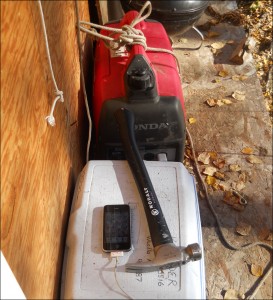
Success! My connection to the outside world re-established. When you have canoes, a hammer, and an iPhone, you’re gonna make it.
Now I had the generator, and hence telephone capacity. I had vessels staged to reach the tracks and the Chase trail, to go south to town, north to the hills, or to go back to Steve’s if needed. Two hours had passed since I got the call from Steve.
All I needed now was for the generator to start.
First pull.
continued in part five…
…Continued from part two.
I spent most of Thursday September 20th close to home, checking the river every five minutes, checking the online river forecast about once an hour, moving things off the
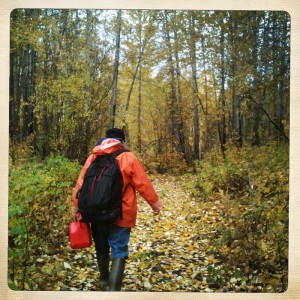
Hauling gas to the wheeler on the other side of the bridge. ( photo taken by Elf on another occasion)
ground, and generally looking around and asking myself “what if”? I moved a few of the dogs back from the river bank into the woods. The wheeler was already parked on the far side of the tracks, as the water under the bridge was too deep to drive it through. I carried some gas out to fill its tank. There were a few things I was worried about, but couldn’t do much about. The snowmachine. The dog houses ( which are plastic drums and would float). The firewood I had spent the last three months accumulating to avoid a repeat of last winter. And the newly purchased pile of metal roofing! All of this stuff I would have liked to move to higher ground. Except they were already on the highest ground I have. It would have to be enough.
In the afternoon I made a quick trip to town and got some work done, but I didn’t want to be gone long, and soon headed back across the river in the ceaseless pouring rain. Darkness came without the river rising a whole lot more. ?I went to bed, slept poorly and awoke often to walk down and check the river level by flashlight.??The forecast was for actual sunshine on Friday,?maybe this was as bad as it was gonna get. Not.
Sometime in the small hours of the dark I fell into a deeper sleep to the sound of crashing logs, and awoke to pre-dawn light. The river could once again be seen as well as heard. And it was up. Way up. The water was over the lower bank and onto the first bench, charging through the trees. Massive logs sailed by like runaway trains and piled into the logjam, which had doubled in size. I moved the rest of the dogs away from the bank. At some point I noticed the sun was shining. This was bizarre. Not only had we not seen it for months, but it shows up NOW, in the middle of this huge flood, like some kind of weird eye-of-the-hurricane thing. Took pictures:
Around ten A.M. I realized I had made a strategic error. On my short trip to town Thursday, I had been in too much of a hurry and had not charged up the reserve batteries for my phone. Now I was running out of juice. Under the circumstances. I didn’t like the prospect of being out there without a communication link. ?I decided I would make the shortest trip I could into town, charge up, and head right back.
When I got to the bridge I discovered that the entire Chase trail southbound was about two feet underwater. The only way left to get to town was on the elevated railroad embankment, on foot. I started walking down the tracks. About halfway to town my phone rang. It was Steve Durr, asking if I had heard the news: There was a three foot “wall” of water due in an hour, and Talkeetna was being evacuated. I turned around and started walking back towards the cabin. Then I remembered that Steve had a generator. I called him back and asked if I could use it. Yes, and would I also grab a couple of valuables out of his tent as well? Yes, I would.
On the last gasp of my phone, I called for reinforcements. Annie was 115 miles away in Anchorage, having just arrived at work. I quickly described the scenario, expecting the phone to die any second. Would she come up? ?Yes. ?She was on the road in about 5 minutes. I pocketed the now dead phone, and started thinking about how I was going to get to that generator, and get it home.
Continued in part four…
…Continued from part one.
Wednesday night, September 19th it was pouring rain all night. This was not remarkable at the time, since it had already been pouring rain for as long as anyone in town could remember. The river roared all night, as it did every night, invisible in the autumn darkness. A soggy Thursday morning dawned, eventually, and I reluctantly crawled out of a warm bed and glanced out the window at the dog yard, as always. Suddenly,?as Han Solo would say, I had a very bad feeling. The back of the dog yard is framed by a nice big clump of birch on the river bank.
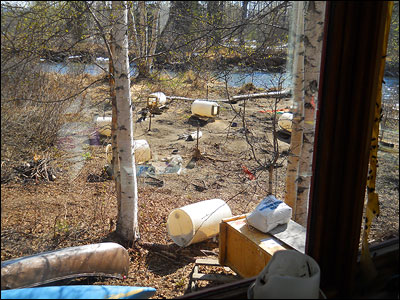
The dogyard in more peaceful times last spring, with the birch clump behind the dog houses.
Except that it wasn’t. The big clump of birch was gone. It was a sensation like waking up and finding that one of your teeth is missing. There was a great big space of nothing where the tree had been, and the dog yard felt naked and exposed to the rushing river. The river was practically deafening, and raging like an angry beast. Trees way bigger than my missing birches streamed past and slammed into the log jam. Some of them were hundred foot tall -I mean long! – cottonwoods four feet in diameter.
Things were getting serious.
Continued in part three…